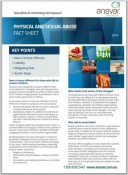Fact Sheet on Physical and Sexual Abuse of Children
December 8, 2014 - 7 minutes read New laws have been passed in the Victorian parliament regarding the abuse of children and all Church of Christ organisations should familiarise themselves with these laws. We also recommend that all churches take advantage of Child Safe membership (free of charge for all insured members) – more information is available here.
New laws have been passed in the Victorian parliament regarding the abuse of children and all Church of Christ organisations should familiarise themselves with these laws. We also recommend that all churches take advantage of Child Safe membership (free of charge for all insured members) – more information is available here.
The information below has been summarised from the 2014 version of the Fact Sheet produced by Ansvar Insurance Limited.
PHYSICAL AND SEXUAL ABUSE – FACT SHEET 2014 – ANSVAR INSURANCE
Key Points covered in the Fact Sheet:
- New Criminal offences
- Liability
- Mitigating Risk
- Action Steps.
1. NEW CRIMINAL OFFENCES
Child protection legislation in the State of Victoria is changing, with two new laws having been brought into effect in October 2014.
Breaching these new laws may result in penalties of between three and five years’ imprisonment.
The new Victorian criminal offences in relation to physical and sexual abuse apply to:
- All adults who fail to report suspected criminal child abuse to the police.
- People in a position of authority in organisations who fail to report child abuse, or fail to protect, reduce or remove a substantial risk that a child will become a victim of a sexual offence.
It’s also important to be aware that it is now a criminal offence to engage in ‘grooming’ of a child – that is, to communicate with children or their parents or carers with the intent of committing sexual abuse.
‘Failure to report’ offences now apply to any adult. Unlike existing mandatory reporting expectations, there will now be a community-wide duty to report, with certain exceptions.
Who needs to be aware of the changes?
The new laws may affect not-for-profits, religious bodies and other organisations that work with children. They may also apply even if people within these organisations are working outside of Australia. All organisations working with children should check to see if and how they are affected.
2. LIABILITY
Who will be most liable?
Board members and senior staff of the organisations outlined above need to be aware of their obligations. Pastors, religious clergy and ministry leaders of churches and other similar organisations should also investigate whether they will be affected.
It is now an offence for any adult (and not just those who work with children) to fail to report suspected criminal abuse of children to the police without a valid reason. This means your staff members, volunteers and contractors need to be aware of their obligations and the criminal convictions associated with failure to meet the standards.
Failure to Protect
It is no longer considered adequate to merely report suspected abuse. Adults who work with children and who fail to remove or reduce the risk to children may also be in breach of the law.
3. MITIGATING RISK
Develop a policy statement on Client Protection
Your church child protection policy statements should reflect the seriousness of this issue and should be presented to all paid and unpaid staff. These statements should clearly communicate the absolute importance of child safety and protection within your oganisation.
Document the way staff members are selected
The methods you use for selecting people to work in your organisation should be formulated in such a way to prevent the abuse of children occurring, and these methods should be clearly documented. This applies not only to paid staff but also unpaid employees, volunteers, students, people on work experience, management, board members, contractors, and others who may act on behalf of the organisation.
At the very least you should ensure appropriate working-with-children and police checks are carried out.
Implementing sound supervision practices
It is also essential to create an environment where the opportunity for incidents of abuse is reduced. Your Client Protection policy should include a section that describes the qualities and behaviours that are expected of people who work with clients, as well as behaviours that are considered inappropriate.
Developing an appropriate response plan
It’s also important that you have a response plan in place so that you will know what to do should an allegation arise.
4. ACTION STEPS
Our recommendations include the following:
- Conduct training sessions to make your people aware of the new laws.
- Update your church’s child protection policies and procedures.
- Update employee induction materials if required.
- Ensure you have adequate procedures regarding staff selection.
- Constantly manage situational and environmental risk in your organisation.
- Create a child safe culture within your organisation.
Ansvar’s full Fact Sheet can be accessed here (but take note that it has since been updated (2015)). If you wish to find out more about the Victorian legislation, you can do so at the Victorian Department of Justice and Regulation site.
Further resources including sample Client Protection Policy and Sexual Abuse Questionnaire are available here.
It’s also important to be aware that CCI will not provide cover for legal liability in cases of sexual abuse where the insured knew or ought to have known that the perpetrator had a history of offences. This is referred to as the “Known Offenders Exclusion” – more information on this can be found on the website or by contacting the CCI office on (03) 9488 8800.
Finally, see our previous article for more information on how the ChildSafe program can help your organisation become a safer place for children.
Written by Tess Oliver
Tags: children, childsafe, legal
Recent Comments